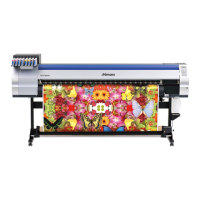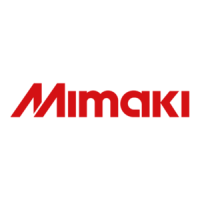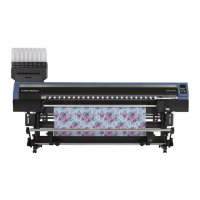Do you have a question about the MIMAKI TS55-1800 and is the answer not in the manual?
Limited warranty information and exclusion of liability for MIMAKI products.
How to get assistance and information on manual change notifications.
FCC statement regarding compliance for digital devices.
Guidance on preventing interference with radios and televisions.
Introduction to the MIMAKI color inkjet printer TS55-1800.
Guide to manual content, usage guidelines, and contact information.
Explains the meaning of symbols used for cautions on operation for safe use.
Warnings on cables, environment, machine use, and body parts.
Safe power connection, heater handling, and maintenance safety notes.
Safe operation, ink pack handling, storage, and disposal guidelines.
Guidelines for proper machine disposal and handling of periodic replacement parts.
Using recommended media, expansion/contraction, and dust precautions.
Ink pack storage conditions and environmental requirements for installation.
Notes for maintenance, and environmental conditions for installation.
Explains interlocks that stop operation when covers are opened.
Location and understanding of warning labels affixed to the machine.
Specific labels, reorder codes, and their descriptions.
Overview of topics covered in Chapter 1: machine parts and installation.
Selecting installation space and optimal temperature for installation.
Initial steps for safely moving the machine on a floor.
Continuation of step-by-step instructions for safely moving the machine.
Identifies and describes parts located on the front side of the machine.
Identifies and describes parts located on the rear and right side of the machine.
Explains the panel, display, status lamps, and ink status indicators.
Details the functions assigned to the FUNC1, FUNC2, and FUNC3 keys.
Describes media sensor, capping station, carriage, rollers, and cutter.
Instructions for connecting the LAN cable and configuring the network.
Guide for connecting the machine via USB2.0 and notes on its usage.
Steps for safely connecting the power cable to the machine and outlet.
Preparing and mounting ink packs for the machine.
Completing ink pack installation into the eco-case and attaching it.
Procedures for replacing ink packs when ink is low or empty.
Explains ink cartridge lamp status and ink expiration date considerations.
Safety guidelines for handling ink packs, including storage and usage.
Weekly maintenance for ink packs to ensure consistent color.
Details usable media sizes and provides cautions for handling media.
Explains the NOT-READY, LOCAL, MENU, and REMOTE operating modes.
Describes procedures and methods for ink/media preparation and printing.
Outlines the primary steps for operating the machine: Power, Media, Test Print, Cleaning, Data.
Detailed safe power management instructions for the machine.
Guides for setting media and adjusting head height for optimal printing.
Detailed steps for loading roll media onto the machine's holders.
Continuation of steps for loading roll media, including media handling.
Using media press, take-up device setup, and media width detection.
Using the take-up device, setting media remaining amount, and residual print.
Instructions for changing the printing origin and adjusting heater temperatures.
Guidance on performing test prints to check for nozzle issues and media handling.
Instructions for performing head cleaning based on test print results.
Procedures for correcting media feed amount and dot positions for print quality.
Steps for starting, stopping, clearing, and cutting print data and media.
Describes the various settings available for the machine.
Introduces the SETUP MENU for customizing print conditions and shows menu navigation.
A table detailing SETUP MENU functions, set values, and their meanings.
Instructions for registering and resetting optimal print conditions into SETUP 1-4.
Guides on correcting the media feed amount using a test pattern.
Details on correcting media feeding rate and dot positions during printing.
Configuration for heater temperatures, off-time, and logical seek operations.
Adjusting the number of ink layers applied for overprinting.
Configuring drying time for ink and setting left/right margins for printing.
Adjusting vacuum fan settings to prevent media rise-up during printing.
Controls for the suction fan and adjustments for media feeding speed.
Configuring intervals and types for automatic head cleaning operations.
Options for external heater control and Mimaki Advanced Pass System (MAPS4) configuration.
Adjusting pass density for shading differences and setting pre-feed for media handling.
Instructions on how to change the names of the registered setting types.
Introduces common settings for easy machine use and shows menu navigation.
A table detailing MACHINE SETUP MENU functions, set values, and their meanings.
Setup for sending email notifications for machine events.
Configuration for automatic mode switching, interior lighting, and resetting settings.
Configuration for auto power-off, take-up unit operation, and top blower function.
Controls whether the machine displays the remaining media amount.
Configuration for automatic media detection at startup and its speed.
Options for changing the machine's display language and setting the time difference.
Adjusting units for temp/length, key buzzer, print spacing, and feed modes.
Steps for setting up network parameters like IP address and DHCP.
Detailed guide for configuring email notifications for machine events.
Enabling event mail, selecting events, setting addresses and subjects.
Detailed steps for configuring SMTP server settings for email functionality.
Procedure for sending a test email and troubleshooting error codes.
Settings for auto remote mode, interior lighting, and resetting machine configurations.
Overview of nozzle check operations and a table of information menu items.
Details the process of nozzle checking and actions during nozzle missing errors.
How to enable printing checks, automatic nozzle recovery, and judgment conditions.
Explains how to view machine information and lists available data items.
Instructions for viewing detailed machine information and maintenance status.
Covers daily care, maintenance procedures, and ink cartridge upkeep.
Essential safety precautions and guidelines for performing machine maintenance.
Instructions for cleaning exterior surfaces and the platen.
Procedures for cleaning media sensors and the media press component.
Weekly maintenance for ink packs to ensure consistent color.
Introduces the MAINTENANCE MENU for performing maintenance operations.
A table detailing MAINTENANCE MENU functions, set values, and their meanings.
Procedures for cleaning the capping station, including the wiper.
Instructions for cleaning the ink cap rubber and the cap absorber.
Steps for performing nozzle washing and cleaning related components.
Procedure to clean the ink discharge passage to prevent ink clogging.
Steps for preparing the machine for long-term storage, including cleaning.
Steps for cleaning the cap rubber and refilling cleaning solution.
Detailed instructions for carefully cleaning the ink head and surrounding areas.
How to use the nozzle recovery function to compensate for missing nozzles.
Steps to specify missing nozzle positions and register them for recovery.
How to reset the set values for nozzle recovery configurations.
Checks conditions that prevent nozzle recovery and how to enable it.
Configuration for automatic maintenance operations like refreshing and cleaning.
Instructions for replacing the machine's wiper and wiper cleaner.
Procedure for replacing the ink cap, a consumable item.
Steps for replacing the cap absorber, a consumable part.
Instructions for replacing the media press if it becomes deformed or rubs against the head.
Guide for replacing the pinch roller when it is worn or dirty.
Continuation of pinch roller replacement steps.
Instructions for replacing the carriage filter when it gets dirty.
Procedure for replacing the male connector absorbent for ink pack maintenance.
Instructions for replacing the blow down fan filter.
Guide for replacing the cutter blade, a consumable product.
Correcting waste ink volume, changing capacity, and handling confirmation messages.
Detailed steps for replacing the waste ink tank and resetting its volume.
Describes corrective measures for phenomena and procedures to clear error numbers.
Resolving power, printing, and media jamming problems.
Solutions for heater temp, image quality, nozzle clog, and ink issues.
Immediate actions to take in case of ink leakage.
Displays warning messages with illustrations and corresponding measures.
Continues listing warning messages with illustrations and measures.
Common operational errors, their causes, and measures.
Error messages displayed in local mode, with causes and solutions.
More local mode error messages, causes, and measures.
Details ink-related error messages, their causes, and recommended measures.
Lists errors related to temperature, connections, and power supply.
Lists errors related to main PCB, memory, and communication issues.
Details errors related to sensors, ink IC chips, and cartridge status.
Lists errors related to NCU, head height, and parameter ROM.
Explains the SYSTEM HALT message and troubleshooting steps.
Contains lists of specifications and functions of the machine.
Detailed specifications of the TS55-1800 printer, including print head and dimensions.
Details on ink supply, capacity, shelf life, storage, and transportation.
Shows the correct order of ink cartridges for different color models.
A form for reporting troubles and abnormal functions to sales offices.
| Connectivity | USB, Ethernet |
|---|---|
| Type | Roll-to-Roll |
| Technology | Inkjet |
| Resolution | 1, 200 x 1, 200 dpi |
| Resolution (Specific) | 1, 200 x 1, 200 dpi |
| Ink Type | Dye Sublimation Ink |
| Ink Color | Cyan, Magenta, Yellow, Black |
| Ink Supply System | Bulk Ink Supply System |
| Media Roll Diameter | Up to 250 mm |
| Power Supply | AC 200 - 240 V, 50/60 Hz |
| Printing Method | On-demand piezo head (Variable dot) |
| Maximum Print Width | 1, 940 mm (76.4") |











